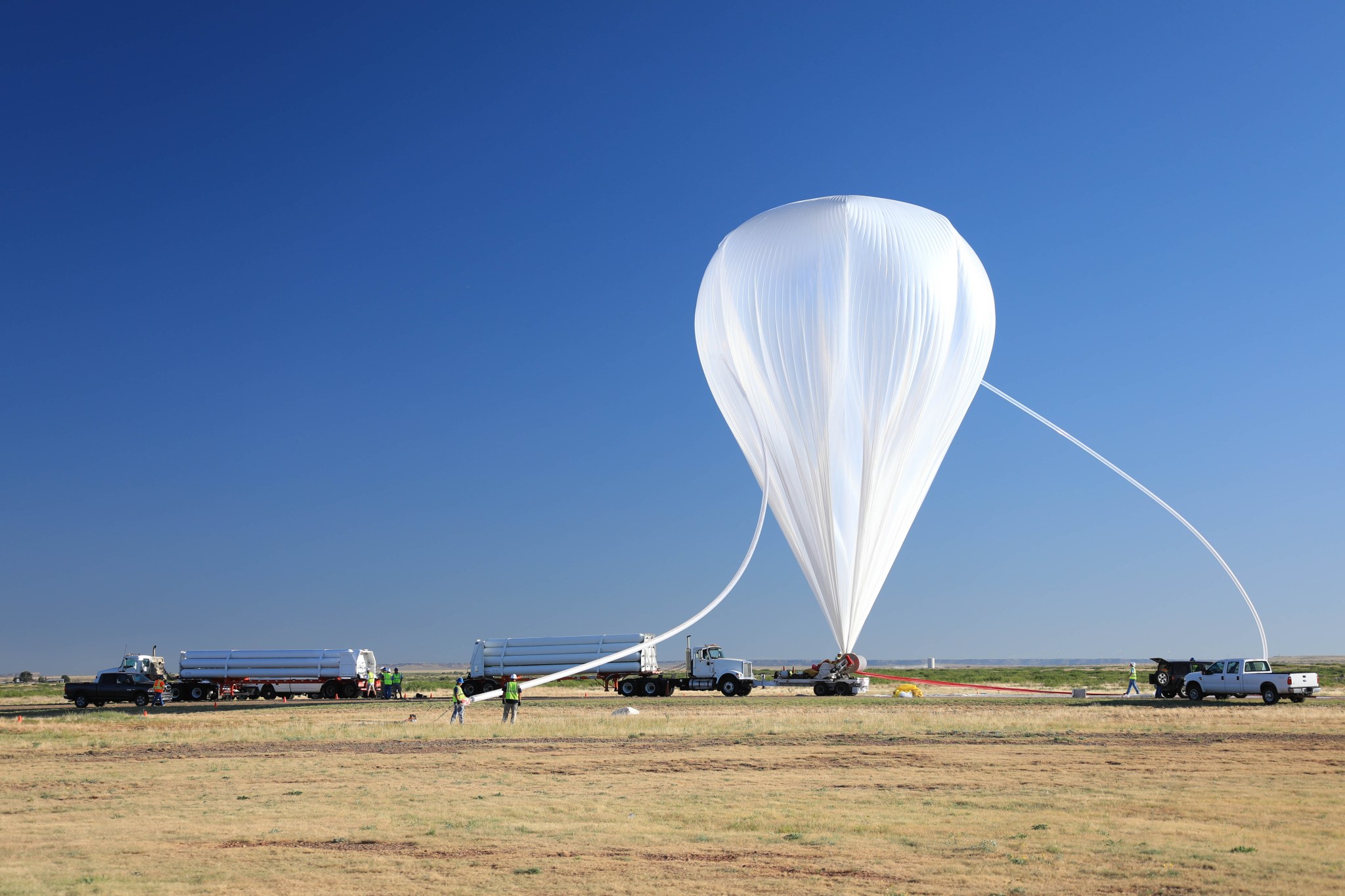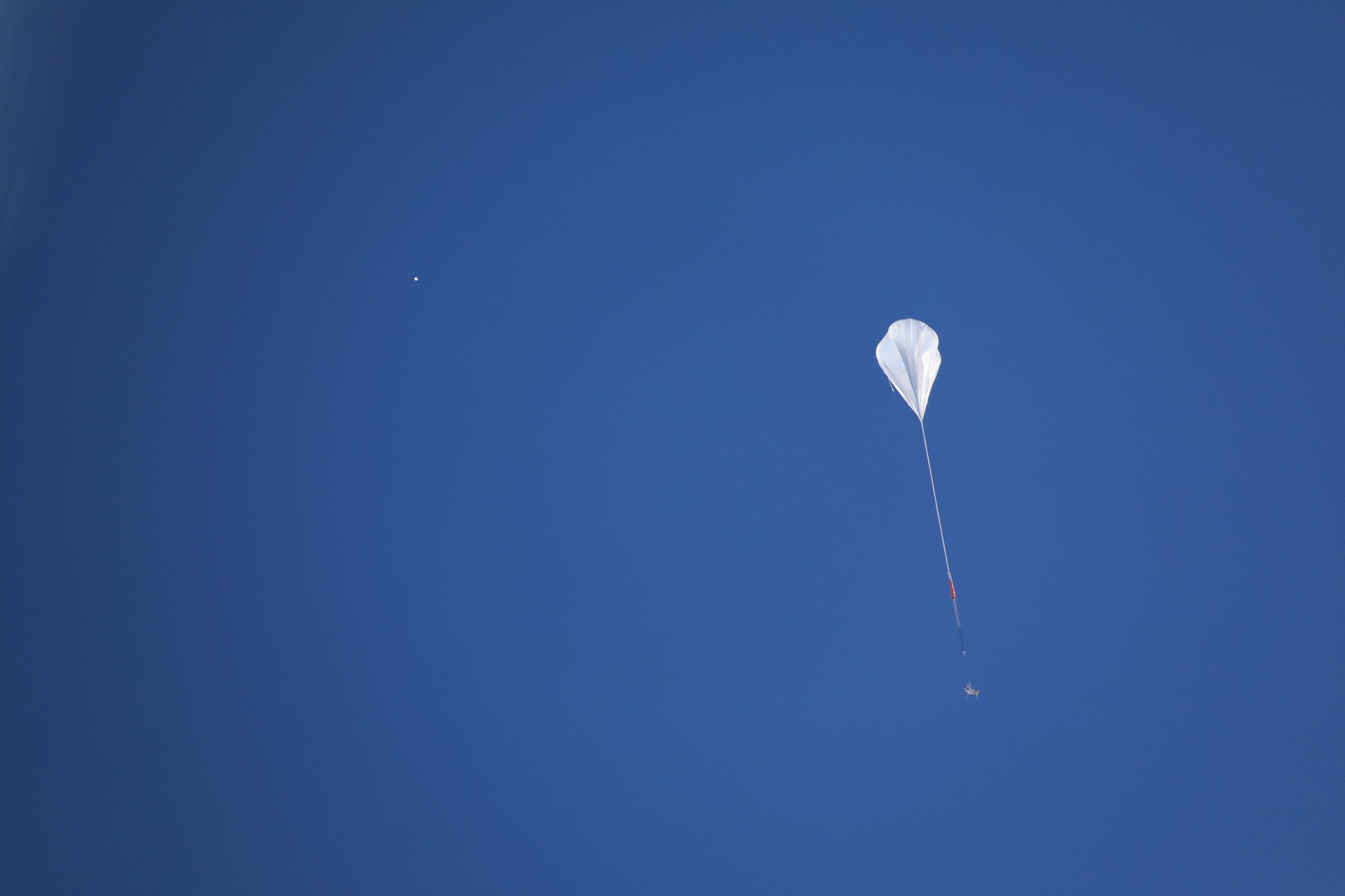UPDATE June 11, 2021: The test flight carrying the All-Sky Heliospheric Imager, or ASHI payload lifted off on June 10 at 8:28 a.m. EDT / 6:28 a.m. MST. The flight lasted 17 hours and 37 minutes and touched down on June 11 at 2:05 a.m. EDT / 12:05 a.m. MST northwest of Hunter Creek, Arizona.
UPDATE June 9, 2021: The test flight carrying the Balloon Observation of Microburst Scales, or BOOMS and BALloon-Based Observations for sunlit Aurora, or BALBOA, missions lifted off from the Columbia Balloon Scientific Facility on June 8 at 8:56 a.m. EDT / 6:56 a.m. MST. The flight lasted 15 hours and floated to an altitude of 117,300 feet. The balloon descended and touched down northeast of Chino Valley, Arizona, on June 9 at 12:54 a.m. EDT / June 8 at 10:54 p.m. MST.
UPDATE 10:00 a.m. EDT, May 5, 2021: The Balloon-Borne Chirpsounder demonstration flight was launched on a zero-pressure scientific balloon May 4, 2021, at 1 p.m. EDT from Fort Sumner, New Mexico. The balloon flew ~4 hours before it descended south west of Albuquerque, New Mexico. Preliminary indications show operations performed nominally.
A suite of scientific balloons is about to lift off from NASA’s Columbia Scientific Balloon Facility’s field site in Fort Sumner, New Mexico, carrying instruments that will help scientists understand the connection between the Sun and Earth.
The Sun sizzles at the center of our solar system 93 million miles away, but its influence doesn’t end there. It exhales the solar wind, a continuous stream of charged particles that whisks past Earth and continues for more than 4 billion miles. Sudden bursts in the solar wind can trigger beautiful auroras on Earth, but can also disrupt radio and GPS signals, threaten our satellites, and pose a risk to electrical power grids at the surface.
Among the six balloon flights to take off between now and mid-June, four experiments will study different aspects of the Sun’s influence. They will focus on the stretch of sky 60-300 miles (100-50 kilometers) above the surface, where Earth’s upper atmosphere and space meet. In addition to generating new science, balloon experiments like these offer a low-cost way to test new instrument techniques and provide valuable opportunities for early-career scientists to gain hands-on experience.
ASHI: All-Sky Heliospheric Imager
The All-Sky Heliospheric Imager, or ASHI, is a piggyback payload that will fly along with the Columbia Scientific Balloon Flight (CSBF) Test Flight II no earlier than May 5, 2021. ASHI’s flight will test the instrument’s capability to reduce stray light and observe the solar wind from here on Earth. About the size of a car wheel and weighing about 33 pounds (15 kilograms), ASHI will sit atop the balloon and peer upwards to attempt a complete view of one hemisphere of the sky. ASHI has a fisheye lens and detector encased below a corral that greatly reduces stray light in order to capture its wide-angle view.
This balloon test flight is in preparation for a potential future flight aboard a geostationary satellite. The team is assessing ASHI’s ability to reduce stray light from the Sun, Moon, and Earth, and its potential to quantitatively view and measure the solar wind as it passes Earth. ASHI is led by Bernard Jackson, a space scientist at the University of California, San Diego.
BALBOA: BALloon-Based Observations for sunlit Aurora
BALBOA, short for BALloon-Based Observations for sunlit Aurora, will test a wide-view infrared camera designed to study daytime auroras. Since auroras keep mostly to Earth’s north and south poles, BALBOA will image airglow, the natural glow of Earth’s entire atmosphere, on this test flight.
Scientists study auroras to better understand how our planet reacts to incoming energy and particles from the Sun. Auroras have mostly been studied at night, but they occur during the day too – sunlight just makes it impossible to see them. In particular, sunlit auroras interest space scientists because they occur on the side of Earth that is facing the Sun: where the interactions between Earth and the Sun kick off.
BALBOA will fly as a piggyback payload on the CSBF Test Flight I no earlier than April 29, along with BOOMS (see below). The mission is led by Xiaoyan Zhou, a space scientist at the University of California, Los Angeles.
BBC: Balloon-borne Chirpsounder
BBC, short for Balloon-borne Chirpsounder, will demonstrate new technology for studying the ionosphere. The ionosphere is the part of the upper atmosphere that is electrically charged by the Sun. This sea of charged particles undergoes constant changes, shrinking and swelling in response to both Earth’s weather from below and the Sun’s activity from above.
BBC will fly about 25 miles above the surface, where it will send radio signals up into the ionosphere. BBC will measure how the radio signals ping off and through the ionosphere before bouncing back to its detectors. In a manner mimicking echolocation, BBC’s measurements can be used to determine the density and height of this part of the atmosphere, where changes can interfere with our communications systems, like radio and GPS. Technology tested during this balloon flight could be adapted for future spaceflight.
BBC will fly on a hand-launched balloon no earlier than April 29. The BBC mission is led by Alex Chartier, an ionosphere researcher at Johns Hopkins University Applied Physics Laboratory in Laurel, Maryland.
BOOMS: Balloon Observation of Microburst Scales
BOOMS, or Balloon Observation of Microburst Scales, is designed to observe microbursts, flashes of X-ray light that sporadically appear in the polar atmosphere. Microbursts are sparked when high-energy electrons surrounding Earth plunge into our atmosphere and collide with atmospheric gases, releasing bursts of light in X-ray wavelengths. These X-rays are quickly reabsorbed by the atmosphere, so they can’t be measured from the ground. Thus, a balloon-borne instrument is necessary to observe them.
Microbursts happen in short durations – about 100 milliseconds – over small areas, from a few miles to tens of miles in the polar latitudes where auroras form. Scientists have known about them for more than 60 years, but have never captured the high-resolution imagery needed to understand what causes them. Balloons, which travel slowly enough to see auroras come and go in the same location, are ideal for pinpointing when and where they occur.
The flight from Fort Sumner will not observe microbursts, which occur at higher latitudes; the team is testing the instrument for a future launch from Sweden. BOOMS will fly as a piggyback payload on the CSBF Test Flight I no earlier than April 29, along with BALBOA. The BOOMS mission is led by John Sample, a space scientist at Montana State University in Bozeman.
Related:
- NASA’s Scientific Balloons Return to Flight with Spring 2021 Campaign
- Video: NASA’s New Solar Scope Is Ready For Balloon Flight
By Miles Hatfield and Lina Tran
NASA’s Goddard Space Flight Center, Greenbelt, Md.































